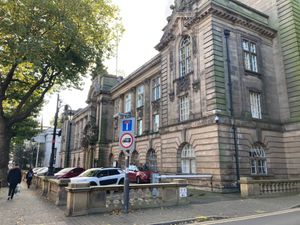Public inquiry opens over plans for battery storage plant in Walsall countryside
A highly charged public inquiry has begun into plans for a Battery Energy Storage System (BESS) on green belt land in Walsall.
Watch more of our videos on ShotsTV.com
and on Freeview 262 or Freely 565
More than 30 protesters gathered outside Walsall Council at the start of the inquiry on November 5 to raise major concerns about the proposed development on Chapel Lane, Great Barr.
At the heart of the inquiry is a planning application to install a 49.35MW battery storage system spanning 3.2 hectares, with 44 storage units, two substations, a 15-metre communications tower, and several access routes.
The intended lifespan of the ‘temporary’ facility is 40 years, with its primary function to store electricity from the grid during off-peak hours and release it during periods of high demand.
Planning officers at Walsall Council had refused permission for the development due to fire safety risks, loss of greenbelt, noise and industrial appearance. However the applicant, Anesco Ltd, challenged the council’s decision with a non-determination appeal to the planning inspectorate.
The public inquiry taking place until November 21 will see representatives from the community, the council and Anesco each put their cases before the planning inspector to make a decision on whether to override the council’s refusal.

Day one started with protesters gathering on Lichfield Street. Inside the inquiry, the public gallery was full and 15 speakers against the development were in attendance.
It included teachers from nearby schools, speakers from the Beacon Action Group, a spokesperson on behalf of MP Wendy Morton and various residents sharing expertise in law, bat conservation and heritage.
The words ‘explosive’, ‘danger’ and ‘risk to life’ were heard repeatedly by the speakers. References were made to another BESS site in Liverpool which set fire in 2020.
Bob Winkle, chairman of the Beacon Action Group, said: “If today an unexploded bomb was found on this field, the authorities would evacuate the area because they could not put lives at risk.
“It seems that this doesn’t apply to this potentially explosive device and we are expected to live in fear for the next 40 years knowing that any day or night this could blow up, despite scientists telling us they wouldn’t live within one mile of it.”
Other major concerns raised were toxic gases arising from the site if a fire were to occur, the effect on students at nearby Barr Beacon and St Margaret’s schools and the evacuation of elderly residents at nearby caravan site at Beacon Heights.
Fire risks aside, other concerns included how the ‘delicate’ country lane with a weight limit of 7.5 tonnes would handle the HGVs required for construction, the ‘vibrations’ during the construction damaging nearby listed buildings, the hum of the storage system and associated air conditioning units disturbing wildlife, flood risk, loss of green belt, loss of land which could be cultivated and the aesthetic of the development.
Anesco Ltd presented its case for appeal and said no suitable alternative sites were available for the development. It added the area on Chapel Lane offered very little value to the conservation area and any harm caused by the development would be entirely reversible.
A spokesperson for Anesco said: “This temporary development would cause only reversible, low levels of harm to the conservation area and no harm to any other asset. The council has consistently overstated the risks of the levels of harm arising from what is a modest and much-needed energy scheme with limited and temporary impacts.”





